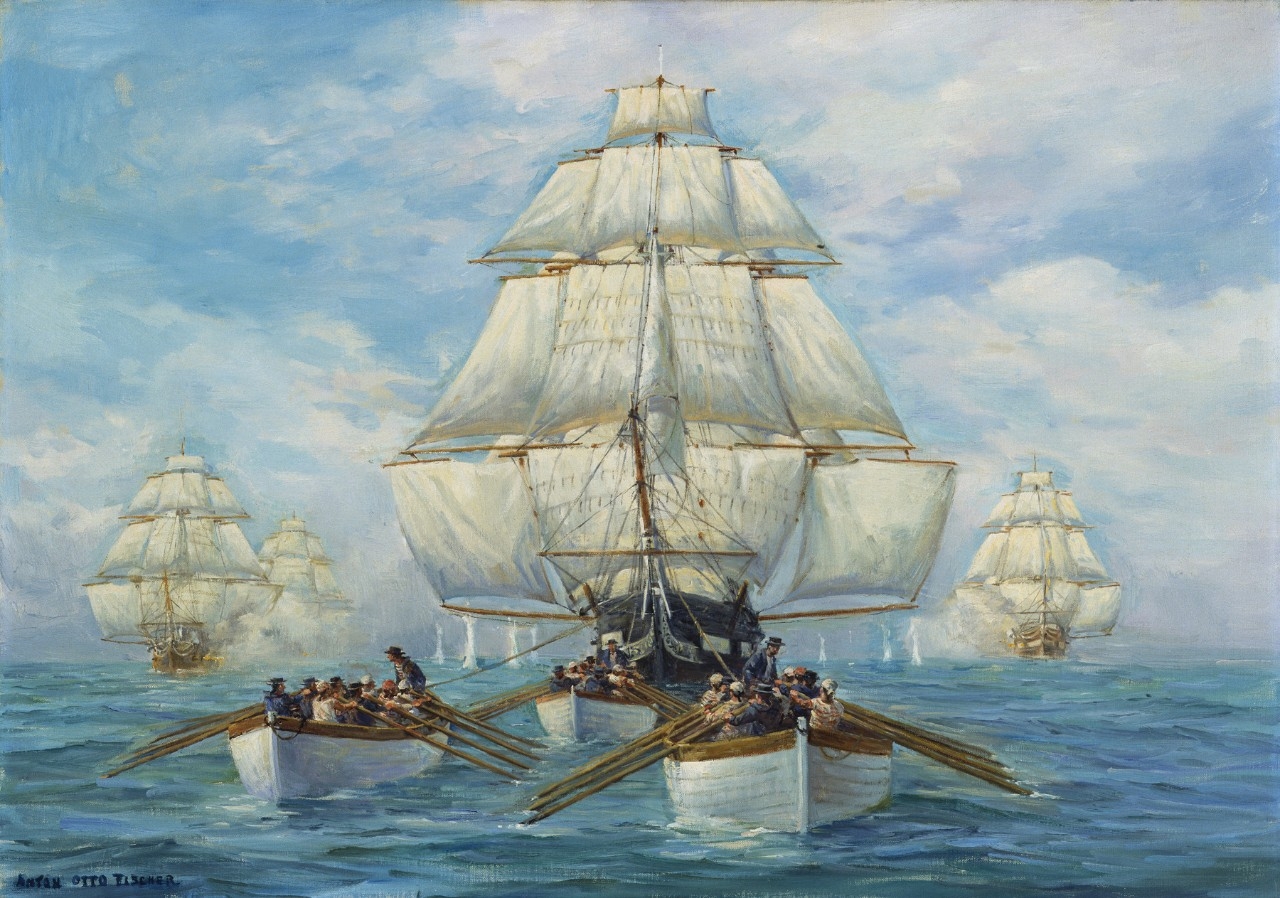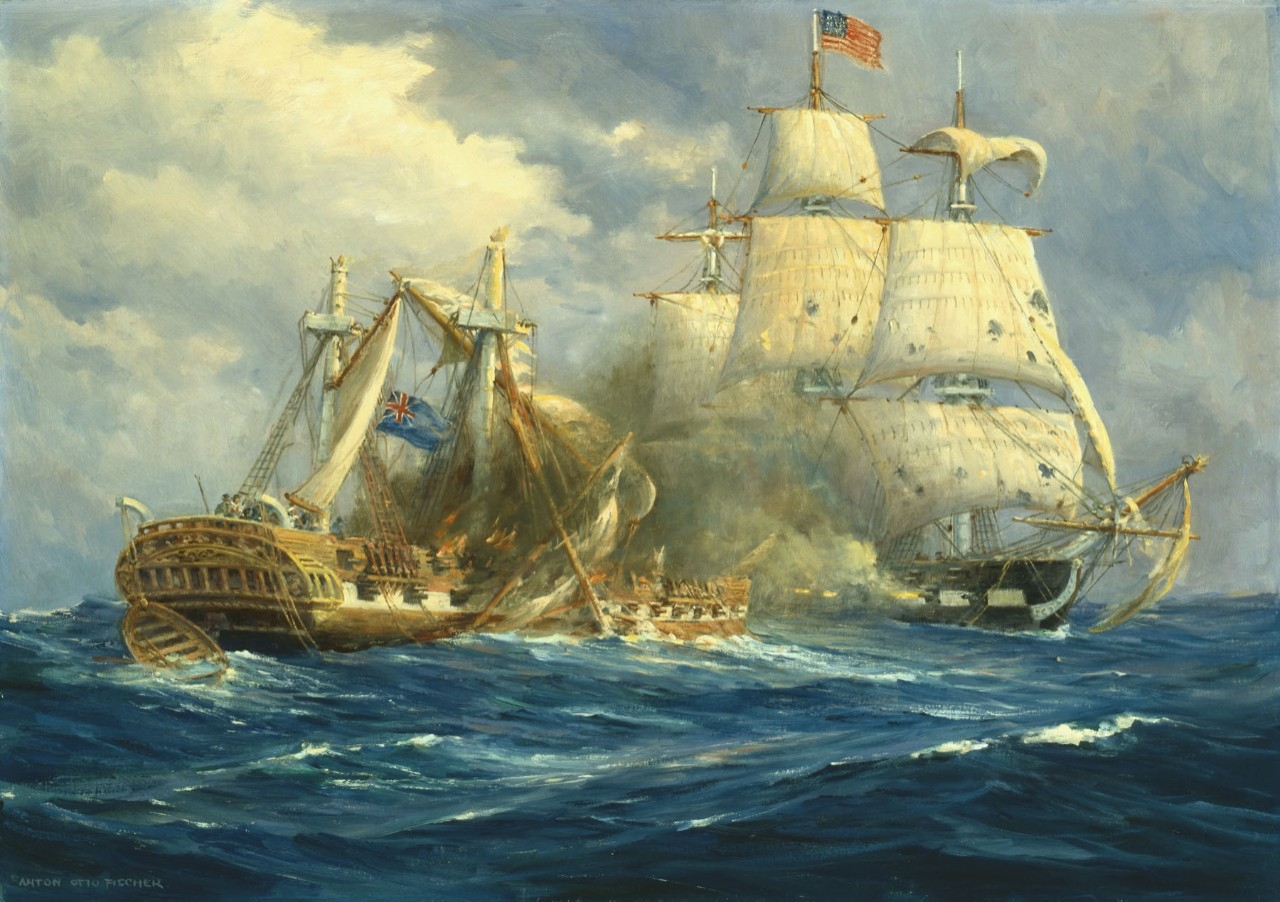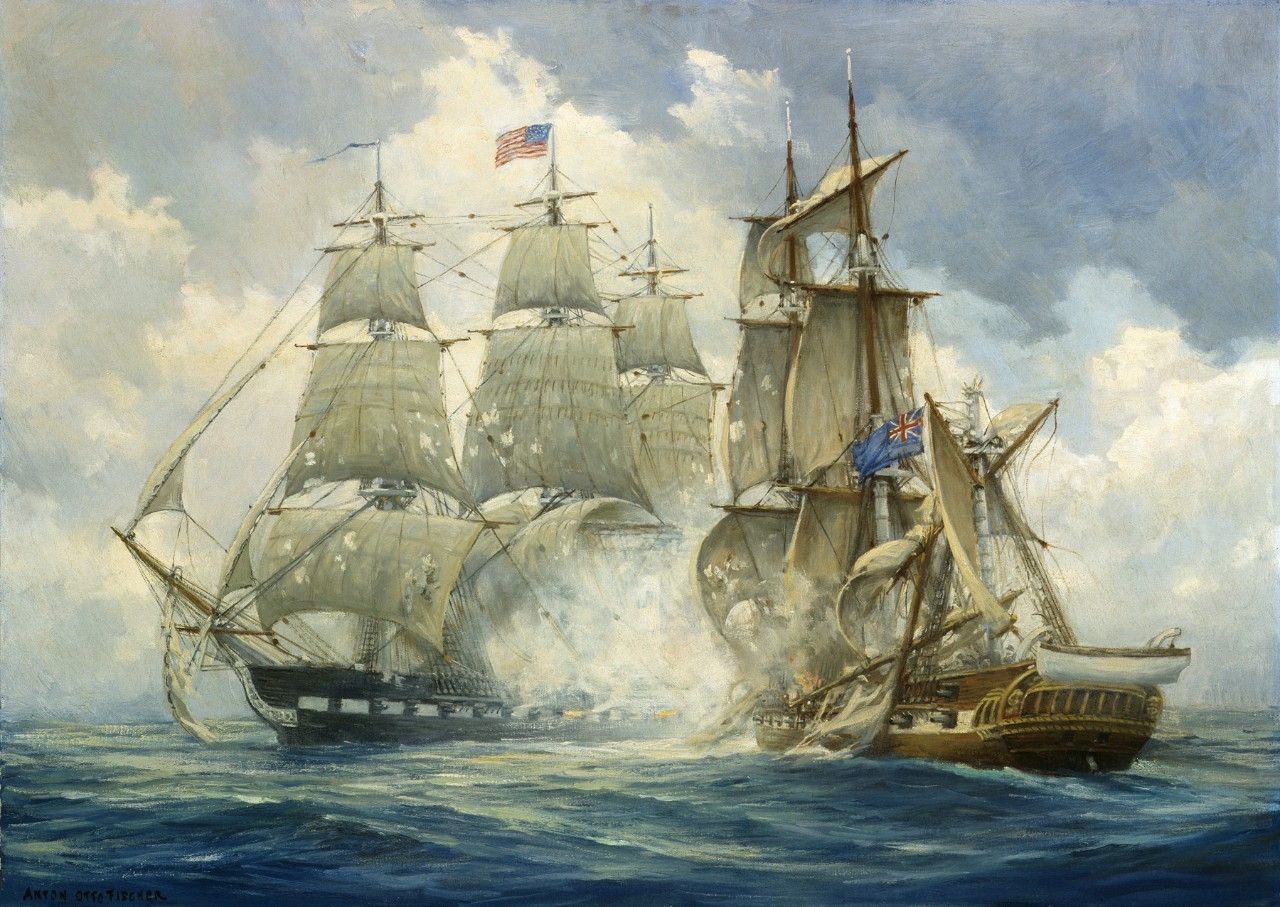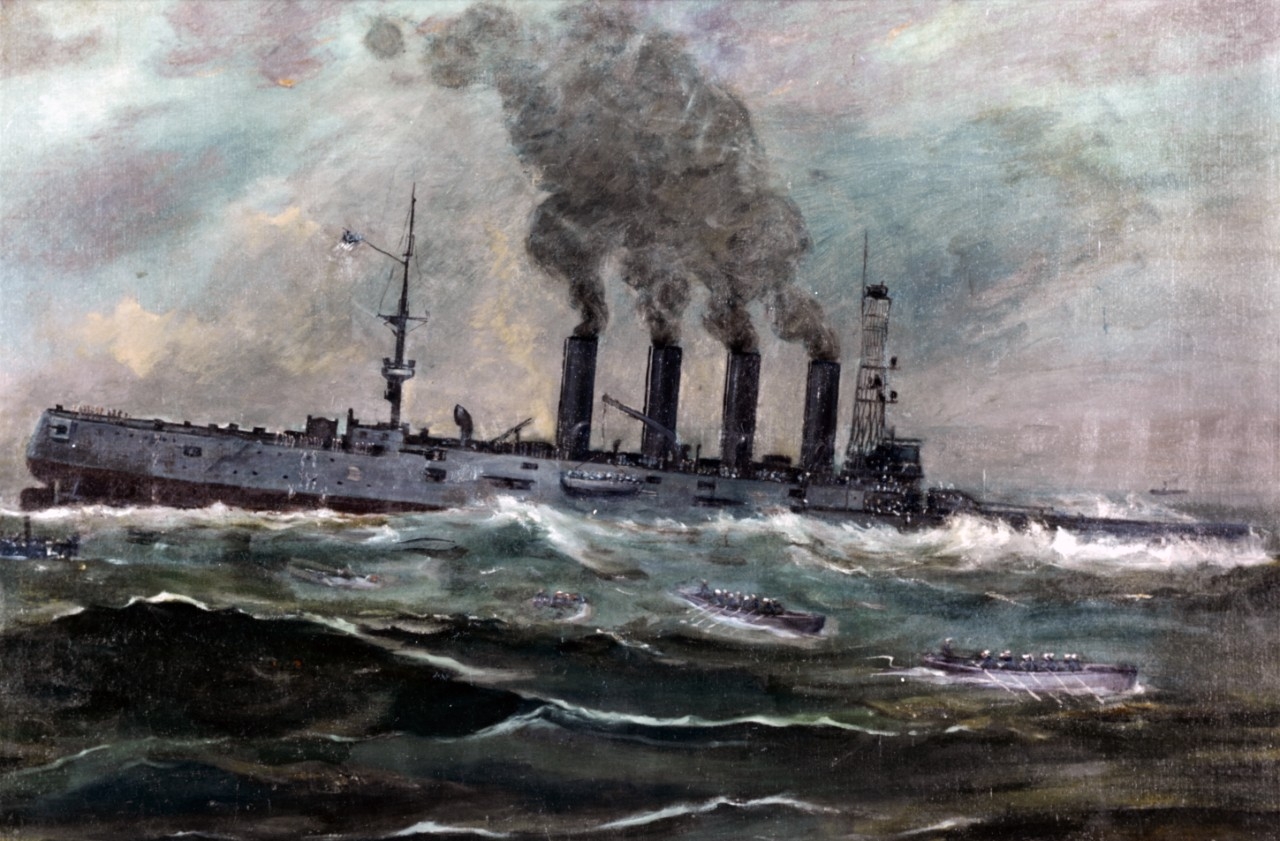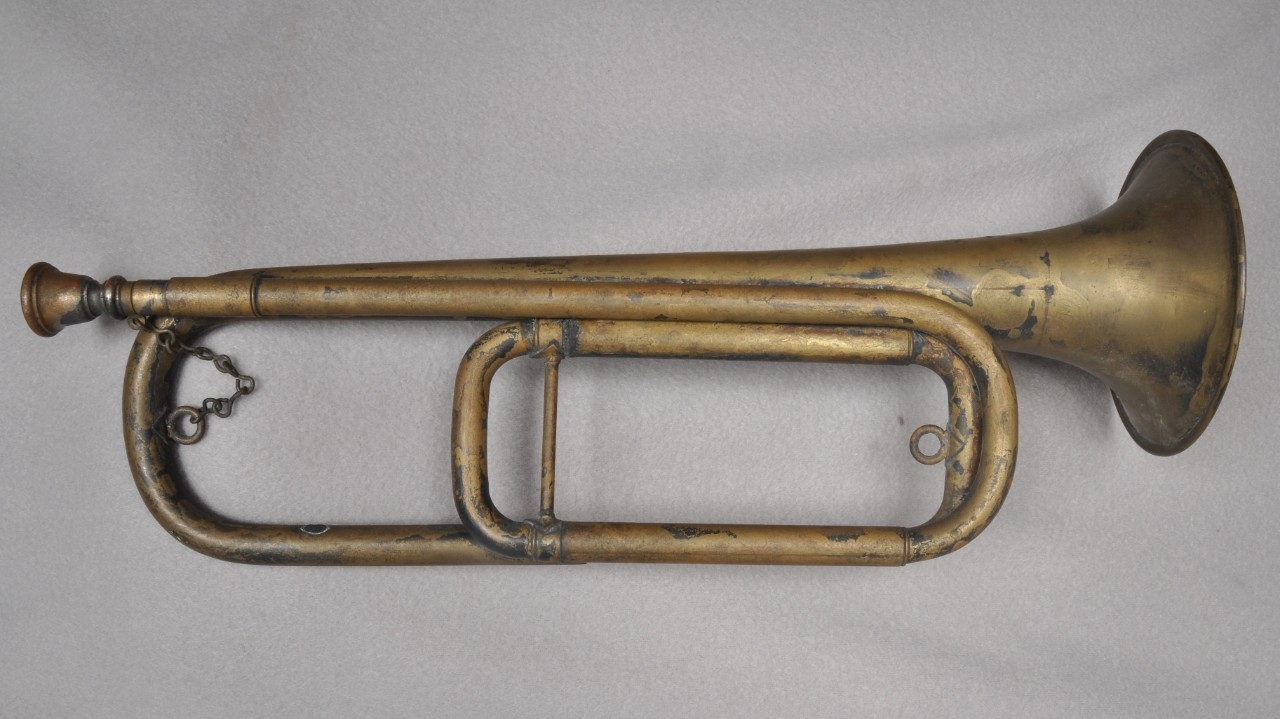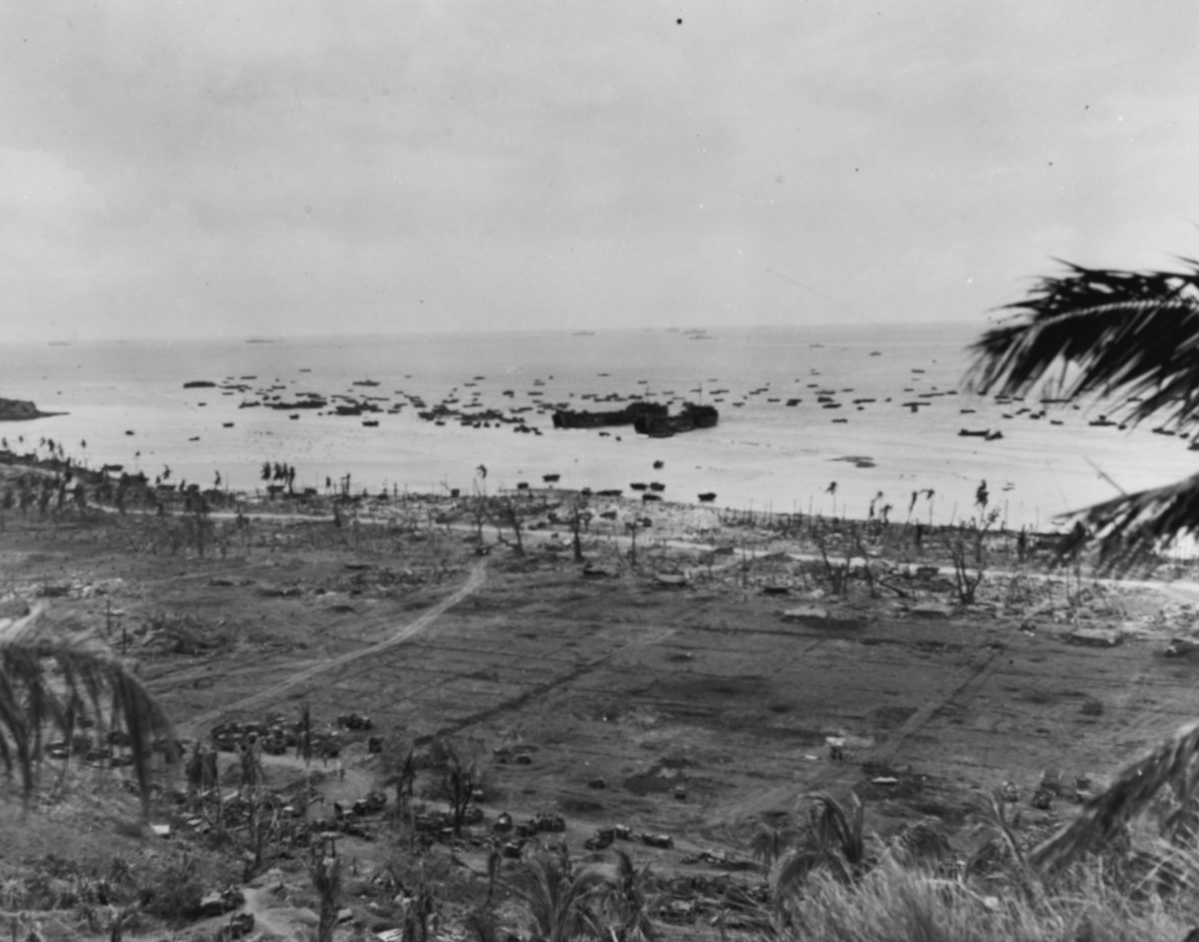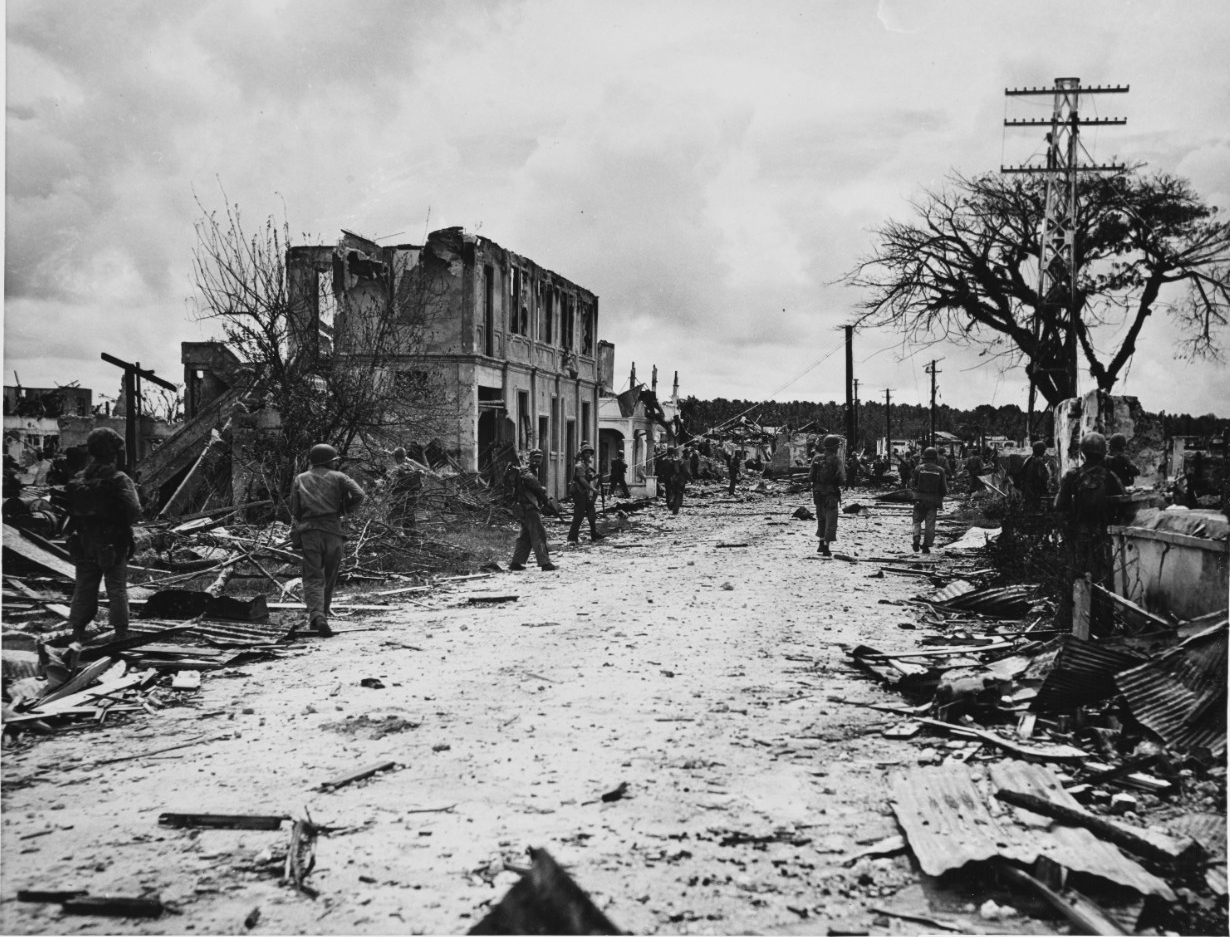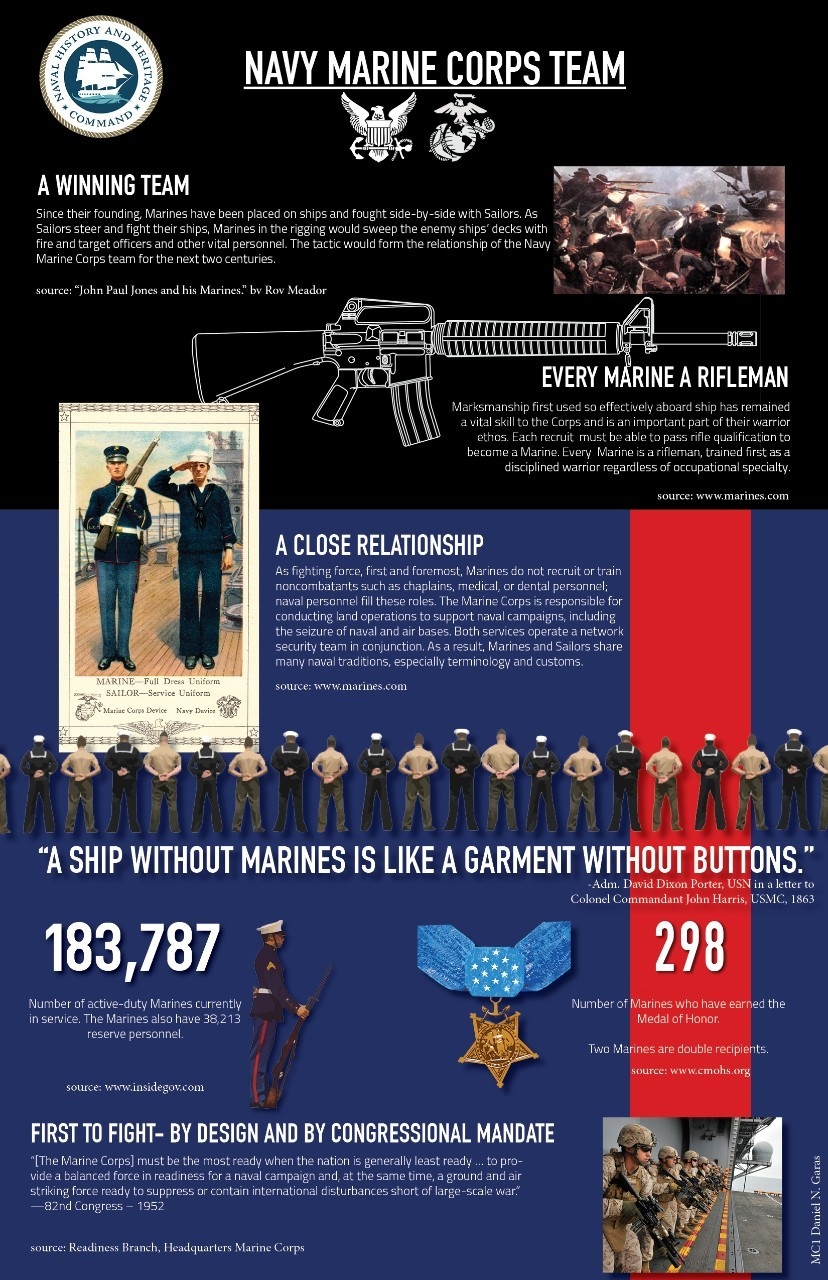Compiled by Brent A. Hunt, Naval History and Heritage Command’s Communication and Outreach Division
War of 1812: Constitution’s Escape
Less than a month after the United States declared war on Great Britain, Capt. Isaac Hull, commander of the frigate Constitution, was at anchor at Alexandria, Virginia, when he was ordered to join Commodore John Rodger’s squadron at New York. On July 16, 1812, Constitution was headed to sea when a lookout spotted a squadron of warships off Great Egg Harbor, New Jersey. At first, Hull believed the ships belonged to Rodger’s squadron, but once he got closer discovered it comprised of five British ships (Africa, Belvidera, Aeolus, Shannon, and Guerriere). Greatly outnumbered, Hull ordered Constitution to turn and run. However, the wind soon died, leaving Constitution and its pursuers becalmed.
Hull immediately made the best of the situation and ordered some guns moved aft so he could fire astern. The crew then began jettisoning stores and provisions to lighten the ship’s weight. Meanwhile, Constitution’s boats began towing the ship away from the enemy in a maneuver called kedging. This operation involved carrying a kedge anchor as far ahead of the ship as its cable would allow. Once the anchor was caught in the seabed, the crew hauled in the cable, and the ship was pulled forward through the water. As the first anchor came aboard, a boat dropped a second anchor ahead of the ship, keeping it in constant motion. This worked well, but the British soon deployed their own kedge anchors. Shannon, the ship closest to Constitution, quickly closed the gap.
This unrelenting, multi-day chase came to an end as the ominous clouds of a squall formed on the horizon. Knowing that the British had copied everything he had done thus far, Hull took a gamble and ordered Constitution’s sails furled. The British, not used to the weather in American waters, followed suit. As soon as the squall struck, Hull quickly spread his sails again and seized upon the wind, leaving the British in his wake. Having escaped their pursuers, the Americans turned toward Boston and arrived there unharmed on July 27. The narrow escape demonstrated Constitution’s sailing capabilities and readiness for war.
Throughout the War of 1812, Constitution proved to be a formidable adversary for the British. On Aug. 19, following the chase, Constitution again sighted Guerriere while cruising off the Gulf of St. Lawrence. As the ships drew nearer to each other, Guerriere opened fire on Constitution. However, the rounds either fell harmlessly into the ocean or glanced off the ship. Hull subsequently gave the order to fire on the British ship, ultimately destroying Guerriere’s mizzen mast, damaging its foremast, and cutting away most of its rigging. Both crews tried to board each other’s ships, but heavy seas prevented it. As the ships began to separate, Guerriere desperately fired point blank into the cabin of Constitution, but the fires were quickly extinguished by the crew. Guerriere was, at this point, dead in the water. The British ship struck its flag and the crew of Constitution boarded the ship, but it was in such bad condition that it was burned and the crew were taken as prisoners. It was a dramatic victory for the young American Navy and Constitution. In only half an hour, the United States “rose to the rank of a first-class power.” Constitution’s victory provided confidence and fresh courage that ultimately strengthened a young nation. It was during this engagement that Constitution earned its nickname “Old Ironsides,” as Sailors reported seeing cannon balls bounce off its hull.
Later that year, Constitution stood out from Boston with Commodore William Bainbridge as its commander. On Dec. 29, while off the coast of Brazil, Constitution added another victory to its already impressive portfolio—the British 38-gun frigate Java. Although it lost its wheel early in the fighting, Constitution shredded Java’s rigging, eventually dismasting it, and mortally wounded the British captain. Java was so damaged that it, too, had to be burned and the crew taken as prisoners. Constitution returned to Boston in early 1813, and Capt. Charles Stewart assumed command of the ship. On Feb. 15, Constitution seized and destroyed schooner Pictou while on a cruise in the Windward Islands, and nine days later, chased another schooner, Pique, which eventually escaped. Constitution also captured three merchantmen on the cruise. The ship safely returned to Boston but was unable to depart for about nine months due to a stubborn British blockade.
In December 1814, Constitution departed Boston and headed southeast. It seized the merchant brig Lord Nelson and later captured Susannah on Feb. 16, 1815. Four days later, it gave chase to frigate Cyane and sloop Levant, which were bound for the West Indies. Constitution opened the engagement by firing its broadsides, and in less than an hour, Cyane struck its colors and soon after Levant surrendered. While sailing with its prizes, Constitution encountered another British squadron that managed to retake Cyane. As the frigate continued to head stateside, the crew received word that peace terms had been agreed upon and the war had ended. During the war, Constitution ran the blockade at Boston seven different times and made five cruises ranging from Halifax, Nova Scotia, south to Guiana, and east to Portugal, where it captured, burned, or took as a prize nine merchantmen and five enemy warships.
Only Major U.S. Warship Lost During World War I
On July 19, 1918, during World War I, USS San Diego (Armored Cruiser No. 6), bound from Portsmouth, New Hampshire, to New York, was sunk southeast of Fire Island, New York, by either a mine or torpedo believed to be from German submarine U-156. The cruiser sank in just 28 minutes. Six Sailors out of the crew of 1,183 were lost. All were enlisted. San Diego was the only major warship lost by the United States during the Great War.
Originally named USS California, the ship was renamed San Diego on Sept. 1, 1914, to comply with the Navy policy of the time to reserve state names for battleships. By then, the ship had been in service for a little more than seven years.
Commissioned on Aug. 1, 1907, the ship became part of the 2nd Division of the Pacific Fleet and took part in the naval review for the Secretary of the Navy at San Francisco in May 1908. Aside from a cruise to Hawaii and Samoa in the fall of 1908, the ship operated along the West Coast, sharpening its readiness through training exercises and drills. In December 1911, it steamed for Honolulu, and in March 1912, continued westward for duty on the Asiatic station. After that service, it returned home in August and was later ordered to Corinto, Nicaragua, which was embroiled in internal political disturbances. While there, the ship and crew protected American citizens and property. It then resumed operations along the West Coast, cruising off California and keeping a watchful eye on Mexico, which, at that time, was mired in civil war.
After being renamed in 1914, San Diego intermittently served as flagship for the U.S. Pacific Fleet’s commander in chief until an explosion in the No. 1 fire room on Jan. 21, 1915, put it in Mare Island Navy Yard, California, in reduced commission through the summer of 1915. Two Sailors, Ensign Robert Webster Cary Jr. and Fireman Second Class Telesforo Trinidad, received Medals of Honor for their actions to save their fellow crewmen during the fire. At the onset of World War I, San Diego operated as the flagship for the commander of the U.S. Pacific Fleet’s patrol force until July 18, 1917, when it was ordered to the Atlantic Fleet. Once there, San Diego's mission was to escort convoys through the first leg of their passages to Europe. Based at Tompkinsville, New York, and Halifax, Nova Scotia, San Diego operated in the weather-torn, submarine-infested North Atlantic, safely convoying all of its charges to the ocean escort.
Later in the same year that San Diego was sunk, the Navy conducted its first survey of the wreck. The survey verified the ship was lying upside down and resting on its stacks. Despite salvage contracts being awarded in 1921 and 1957, work wasn’t completed. During this period and subsequent decades, artifacts were removed from the site, including both propellers, which were removed for their scrap metal value. The unauthorized removal of weapons from the site in 1995 prompted the first Naval History and Heritage Command survey of the site.
The site was placed on the National Register of Historic Place in 1998 and falls under the 2004 Sunken Military Craft Act. The act prohibits unauthorized disturbance of sunken military craft—both ship and aircraft—but authorizes the Secretary of the Navy to issue permits under federal regulations allowing for the conduct of scientific research for archaeological, historical, or educational purposes. The permit program is managed by NHHC’s Underwater Archaeology Branch. NHHC continues to manage the site as a sunken military craft, a war grave, and part of the U.S. Navy’s overall cultural resource management program. The command’s Underwater Archaeology and Conservation Laboratory curates a number of artifacts that were recovered without authorization and later returned to Navy custody in recent years. There are 229 artifacts within the San Diego collection under the management of NHHC.
Battle of Guam
On July 21, 1944, Task Force 53, commanded by Rear Adm. Richard L. Connolly, landed the 3rd Marine Division and the 1st Provisional Marine Brigade on Guam. As part of Operation Forager, it was the second battle for Guam during World War II. The first battle took place in December 1941. At that time, Guam was defended by a small, lightly armed garrison of U.S. Sailors and Marines that was quickly overrun by a much larger Japanese landing force. The United States didn't have time to sufficiently mobilize its fleet and resources, as the island fell shortly after the Japanese surprise attack on Pearl Harbor.
Following pre-invasion planning and the subsequent naval bombardment of the approximately 19,000 Japanese personnel and their defenses on Guam, the 3rd Marine Division landed at Asan. Concurrently, the 1st Provisional Brigade landed at Agat, to the south on the other side of Apra Harbor and the Orote Peninsula. Initially, the Army’s 77th Infantry Division was held in reserve. At Asan, landing craft were unable to reach the beaches directly due to a coral reef, so they transferred to amphibious tractors, which carried them to shore. In both the northern and southern sectors, landing forces were met with stiff enemy resistance. Although pre-invasion bombardments and air strikes had destroyed many above-ground defense positions and facilities, enough remained concealed to slow the U.S. advance.
In the northern sector, the Marines faced several serious counterattacks, but they were able to repulse the Japanese. Naval gunfire and the loss of many of their officers kept the Japanese from effectively repelling the U.S. push and reinforcing their defensive lines. In the first week, despite suffering many casualties, the Marines had consolidated their beachhead and advanced toward the center of the island.
Meanwhile at Agat, landing forces faced fierce resistance and pre-sighted mortar and artillery fire, which immobilized numerous amphibious tractors. The loss of the tractors hampered the logistics chain and delayed the landing of the 77th Infantry Division. Japanese counterattacks, in part supported by tanks, continued but were ultimately fended off. Naval vessels provided star shell illumination and fire support throughout. In the south, Marines fought their way north onto the Orote Peninsula and its airfield. On July 25, in an act of desperation, a final Japanese banzai attack occurred but was repulsed. On the afternoon of July 28, the Orote Peninsula was secured. Meanwhile, the 77th Infantry Division pushed east and north to link up with northern sector forces. As they began to withdrawal, the remaining Japanese forces slowly retreated to Guam’s mountainous northeast around Mount Santa Rosa. On July 31, U.S. forces began their final push. The town of Agana was taken that same day. By that evening, all units had reached their daily objectives. The advance continued until the first week of August. The 77th Infantry Division assaulted and captured Mount Santa Rosa on Aug. 7–8. Marines and Soldiers reached key points on Guam’s northern and eastern coasts by Aug. 8 and, two days later, organized resistance on Guam ended. Despite the presence of small bands of enemy troops, who held out in the island’s jungles until after Japan’s surrender, Guam was transformed into a major logistical base that would support the upcoming liberation of the Philippines.
Fighting in the thick jungle and steep terrain of Guam was difficult for both sides. More than 3,000 U.S. service members were killed in action, and more than 18,000 Japanese were dead when the battle was over.
Today in Naval History—The Marine Corps’ Other Birthday
On July 11, 1798, President John Adams signed into law a congressional act that reestablished the Marine Corps. The following day, William W. Burrows was appointed commandant of the newly formed U.S. Marine Corps. The Continental Marines and the Continental Navy had been disbanded following the American Revolution. When the force was first established on Nov. 10, 1775 (the Marine Corps’ official birthday), it was part of the Continental Army. However, the Continental Congress ordered “that particular care be taken, that no persons be appointed to office, or enlisted into said battalions, but such as are good seamen, or so acquainted with maritime affairs as to be able to serve to advantage by sea when required.” The Continental Marines soon thereafter launched an amphibious raid on Nassau in the Bahamas and participated in the Battles of Trenton and Princeton.
After America gained its independence from Great Britain with the signing of the Treaty of Paris in April 1783, it wasn’t until 15 years later that the Marines were reestablished. At the time, the reestablished force would serve in addition to the Army and Navy. Some years later, in 1834, President Andrew Jackson indicated that he wanted the Marines to be part of the Army. However, then–Marine Corps Commandant Archibald Henderson had proven the effectiveness of Marines at sea, in addition to land, and he persuaded Congress to assign the Marines to the Department of the Navy. For more on The Navy and Marine Corps Team, visit NHHC’s website.

